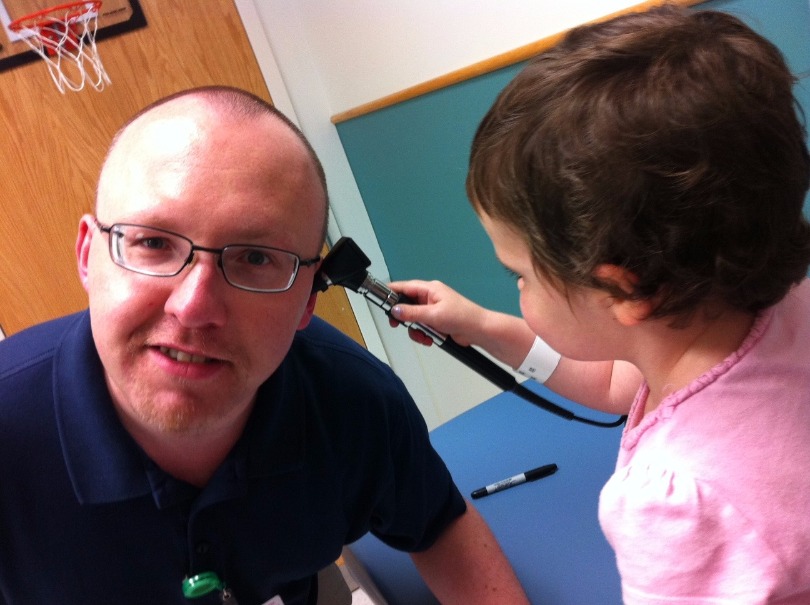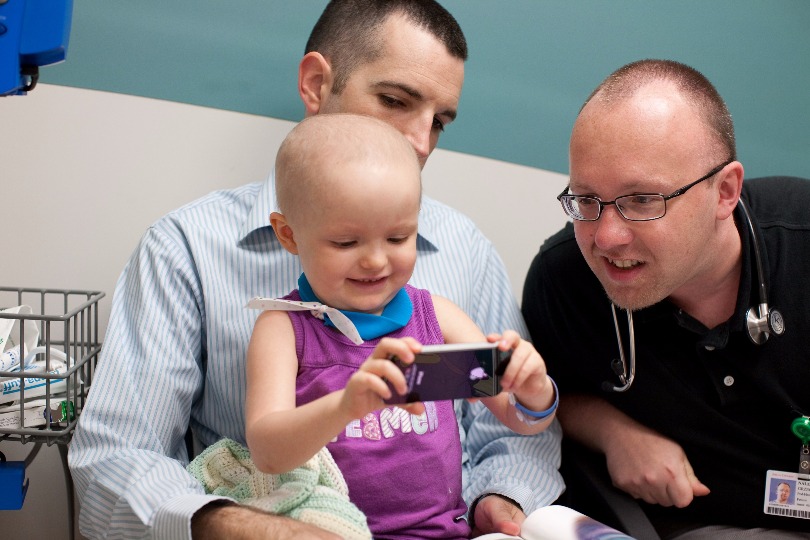It is said that to defeat an enemy, you must know them — and that’s exactly what St. Baldrick’s Scholar Dr. Grzegorz Nalepa is doing. The enemy? Childhood cancer. His weapon? Genomics — the study of all the genes within an organism, like a human child with cancer for instance. Who is winning? Read on to find out. (Hint, hint…it’s the good guy.)

St. Baldrick’s Scholar Dr. Grzegorz Nalepa amuses a young patient by making her the doctor, instead of him.
For St. Baldrick’s Scholar Dr. Grzegorz Nalepa, childhood cancer treatment can’t be one-size-fits-all. To be successful, it needs to be personal.
That’s why this physician-scientist studies what makes everyone unique, including kids with cancer – genes.
With support from St. Baldrick’s and a deep passion for the field of genomics, Dr. Nalepa is studying how the genetic changes, or mutations, present in kids with leukemia can be exploited to create targeted therapies against that cancer, with few side effects.
“The way we treat leukemia now is rather harsh. We have chemotherapy that obviously works and we save most of the kids, which is wonderful, but we don’t save all of them, which is sad,” he said. “Also, those kids who are cured, they have major side effects from the therapy. They lose hair, their blood counts drop, they get mouth sores and serious infections; sometimes they don’t die just from leukemia, but from the side effects of the therapy we use to save their lives.”
Dr. Nalepa is dedicated to changing that current reality for kids with cancer by studying the building blocks of the disease itself and how those building blocks shape cancer’s ability to beat chemotherapy.
It turns out that cancer can close down certain genetic checkpoints, helping it overcome chemotherapy and continue to grow. But in doing so, the cancer relies on certain genes to stay alive.

One of Dr. Nalepa’s patients, Vera, smiles as she plays with a phone while he looks over her shoulder.
When Dr. Nalepa looked closely at these certain genes in cancer cells and the same ones in healthy cells, he noticed something interesting. When you turned off these genes in the cancer cells, they died. But if you turned off the same genes in healthy cells, they “don’t care too much,” he said.
These are what Dr. Nalepa calls, “weak spots” in the genes of childhood cancer. It’s these spots that he wants to target with already available medicines to help kids with leukemia beat the disease, while minimizing the side effects of harsh chemotherapy.
That is what Dr. Nalepa hopes the future will look like for kids with leukemia – personalized, targeted, precision therapies that attack just the cancer and leave healthy cells alone.
He hopes that one day soon, he will be able to walk into the Riley Hospital for Children at Indiana University Health, where he’s a pediatric hematologist-oncologist, and give good news to a family with a child diagnosed with leukemia.
“They’d be crying and terrified about what’s going to happen and I hope that there will be a moment when I would be able to tell them, ‘I can tell you from the research I’ve done thanks to St. Baldrick’s, I can promise you that the strategy we are going to use for your child has a very good chance of working,’” he said.
And Dr. Nalepa is working toward that brighter future, thanks to help from a St. Baldrick’s Scholar Award. In fact, the Indianapolis doctor has one word for St. Baldrick’s support.
“Essential,” he said. “That’s how I can do it.”
You make progress like this possible. Fund childhood cancer research today and give kids with the cancer hope.

 SBF
Tweets »
SBF
Tweets »